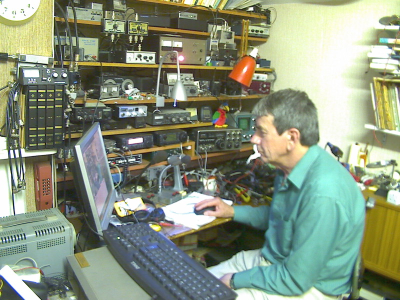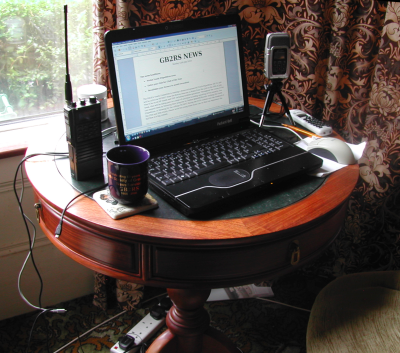G4TRN
UK Amateur Radio Station
Amateur radio is a world wide hobby which crosses all boundaries and embraces people from every walk of life, even royalty. It is regulated by governments and international agreements but very few administrations do not permit its activities.
Radio amateurs are not permitted to use any security coding. Everything we transmit, be it voice, international Morse code, images or data is accessible to anyone with the necessary receiving equipment. It is very public and in the early, experimental, days generally only concerned technical matters. Nowadays it is often much more personal, but it is always public. Unfortunately, bad behaviour and bad language has become a feature of a few operators and some areas of a hobby, which is open to all, even children, who have proved a knowledge of the rules and some technical understanding by passing an examination.
I became interested in radio at about the age of 11 in the early 1950's when I made a crystal set with parts bought from a Manchester market stall following a circuit from my father's wartime Royal Signals Regiment wartime training exercise book. Among his text books were volumes from the Radio Society of Great Britain (RSGB).
For young readers... A 'crystal set' works without batteries and the energy radiated by the broadcast station drives headphones directly. They were very common in the first days of radio and are extremely simple. However, they cannot separate stations very well and you can only hear strong signals.
One of my friends, who was also playing with crystal sets, told me that he had heard a message, not a broadcast, on his. This was the stuff of 'Boy's Own Paper' and we set about finding out more.
The station we heard was an amateur radio enthusiast, call sign G3AO putting out a general call, 'CQ 80', and listening for a reply. By reducing the number of turns on our coil (originally 65 wound on a standard toilet roll) we heard him better, but, unsurprisingly, we never heard any reply.
I was hooked and progressed, making my own radio receivers (and... very naughty, transmitters) throughout my school days. At some stage I became more interested in 'Young Ladies'. Short wave radio was relegated and flute playing, often combined with 'YLs' came to dominate my life.
So much for the early days. Much of what follows is only of any interest to fellow radio operators (hams). After many years away from the hobby I took the exam and became a licenced operator as G6BIZ in March 1981. I later took the then obligatory test in Morse Code and upgraded my licence from 'Class B' to 'Class A' and the current call sign, G4TRN at the end of May 1983.
I have a modest station and have worked all HF and VHF bands up to 70cm. Much of the original 'home brew' units have been pensioned off since I bought an Icom IC706 MkII but I still rely on a linear psu based on the PW 'Marchwood' design. The qth is in a Victorian residential area in the middle of Bristol and I do not have much space. My wire antennas are bent into very strange shapes. The local noise level has grown steadily over the years and it now severely limits operation on the lower HF bands. With high ground to the north and south of me low angle HF reception is rare and VHF propagation is not great despite the height of the antennas above a three and a half storey building.
At the moment I am not very active. However, on most Sundays I perform several news readings for the RSGB under the special call sign GB2RS. There have been changes since I was first roped in to help spread the news reading load and for a time I was the only GB2RS reader in the Bristol area.
2016-May
After enlisting some help a seemingly impregnable adminstrative barrier has been breached and Sean G7NJX has now been issued with the all important NoV (Notice of Variation) to the Amateur Radio Licence that enables him to broadcast on behalf of the RSGB. Sean will share my duties on 2m. at 10:30am 145.525 mHz. His first broacast went out on 5th. June. His lilting Middlesborough accent may cause some listeners to wonder if there is a 'lift' (enhanced propagation) on.
2016-February 21st.
The amateur community in Bristol is saddened by the passing of Cyril Chapman G2HDR. A real 'old timer' and dedicated morse operator with 'ninety two turns on the coil' of his life.
2016-February 19th.
A lot of interest has been generated by the link up between a local school and the ISS. I've not had much time available for fitting my amateur radio activities around the clock since I was at school but today I thought I would have a listen and find out what I could hear. I still remember hearing the bleeps of Sputnik 1, received with a long wire aerial and tuned with a radio that had a bent bit of wire and a scale to judge the frequency. Fortunately, Sputnik 1 was virtually next door to a strong and reliable standard broadcast from the USA (WWV, time and frequency on 20mHz.) I had to tune until I just lost that signal and wait until Sputnik 1 went over. As it went overhead and retreated, the pitch of the bleep changed and became lower, faded and was gone. (The Doppler Effect. Worth looking up if you don't know about it already.)
This time all I had to do was to dial up the right frequency (numbers) 145.800 mHz on my radio's display and wait. The ISS came out of the noise and I heard several of Tim Peak's answers very clearly. Not quite the same 'magic' as it was 6 decades ago, but memorable, none the less. The Doppler Effect was noticeable, not in the pitch of the voice, but in the strength and clarity of the signal as it moved from 145.803 to 145.797 mHz before I lost it completely. I did do a little knob twiddling! You can hear a snatch of my recording by clicking this link
2016
Cyril, G2HDR has had to stop news reading as his health has deteriorated to the point where he no longer has the breath to continue.
July 2015. Revised October 2019
My news reading has just taken on a new dimension. Because of the very limited range of my rather low power transmission on UHF (70cms.) permission has now be obtained to broadcast through the GB3ZB repeater (relay station) on Dundry Hill. The coverage is roughly Minehead to Gloucester taking in the Welsh coast and east to Chippenham. For technical reasons this broadcast has to be of a recording and this requires a new approach. I have moved from the traditional 'shack' (actually in the attic)...

to a domestic area which improves the ambient sound quality. All the recording and transfer of the resulting file is done with a computer. I can even use the computer to communicate with other radio amateurs via radio transmission from the repeater. The only 'radio' directly involved at my end involved is WiFi. How things have changed! I have been joined in this venture by John 2E0CRI and after some small problems the system is working well. John has now moved to Yorkshire and is not heard on ZB now. Distance does not matter if one has an internet connection and in 2019 I recorded and uploaded the broadcast while on holiday... in Yorkshire!.

The picture shows my original recording set up, Zoom H2 microphone, lap-top (EasyNote Vista), Icom IC32E for working GB3ZB ( I can get into ‘ZB with it if I stand near the window!) and the essential mug of coffee. The mug on display is the GB2RS 50th anniversary special edition sent to all news readers in 2005. I used to listen to Arthur Milne, G2MI in Bromley one of the very first readers, on 80m, soon after the service started in 1955!
I've taken to making the recording in the 'shack' now and the system is rather different. The fans that cool my radio gear are not running. I'm using my high spec. Windows 10 'work' computer which has two displays. This makes it easier to keep track of the script and the recording now that they can each have their own screen.
The microphone used to be my 'home brew' desk communication mic connected to the PC with an ION MixMeister USB recording interface via its line input sockets.
I still use the mic with my radio but I found a nice AKG dynamic mic in a junk shop and bought a small Behringer mixer with USB interface to connect it to my Windows 10 PC. (Really quiet mic pre-amp and A/D converter). I found a mic stand and boom with pop screen in another charity shop and everything is a bit more 'professional' now. It pleases the 'broadcast quality' brigade who check me on the input when I have to broadcast the recording. The repeater does some rather drastic tailoring or the audio as it goes through the system. I'll make another page about it one day.
The recording app is Audacity. I record in mono and export at 8000 Hz to .au for GB3ZB (and 32kHz stereo mono .mp3 for this site).There are some unusual features in my microphone circuit and I'll tidy up my schematic and publish it here fairly soon. (Its here now... Mic Amp Uploaded in 2019!)
24th. January 2013.
I feel the need to make a public statement regarding news reading issues that may be regarded as 'political' (within the hobby) and therefore beyond the scope of legal radio transmission. (I am very 'old school' in this respect.) I can direct radio callers who want to know my views via a dedicated amateur radio site. You can find them here.
John Everingham. G4TRN, FTCL
Webmaster
email:- g4trn(at)saundrecs.co.uk